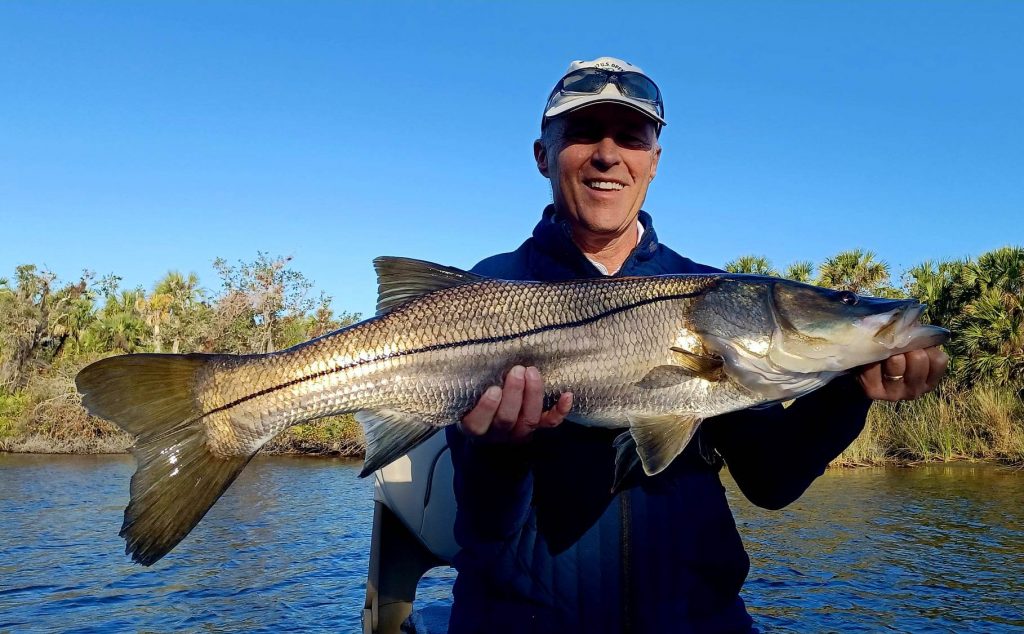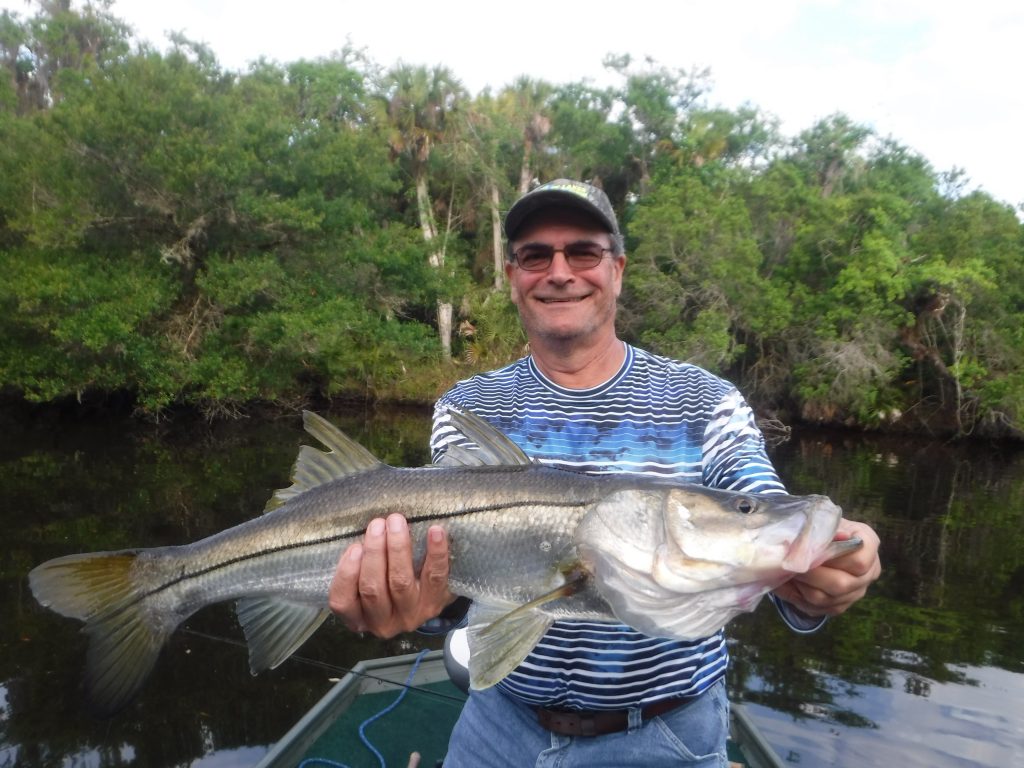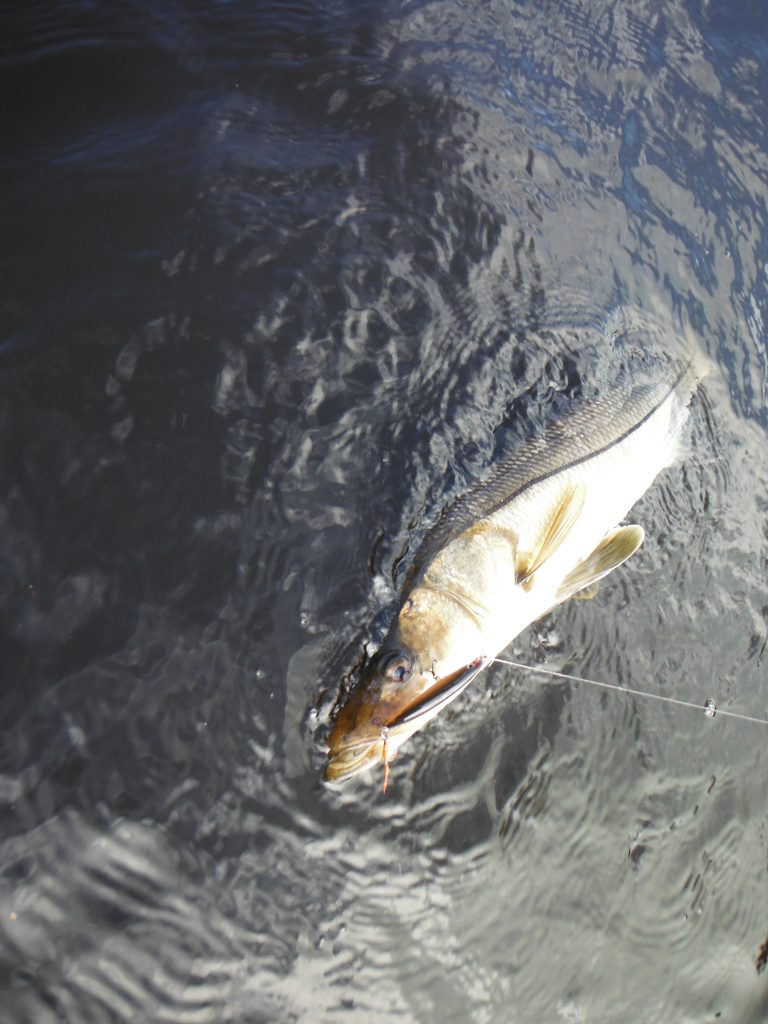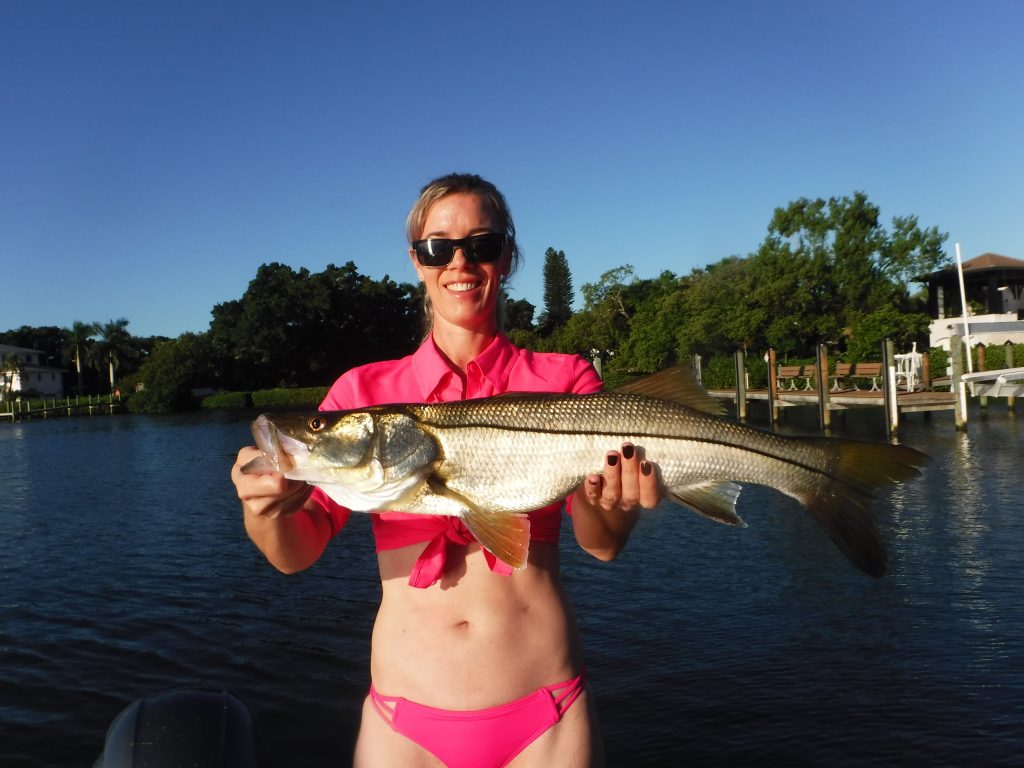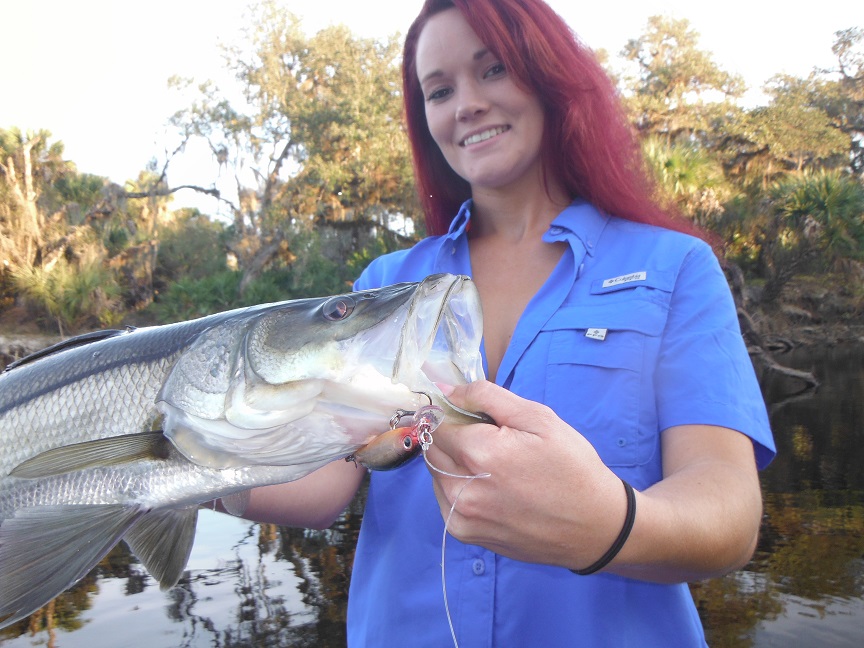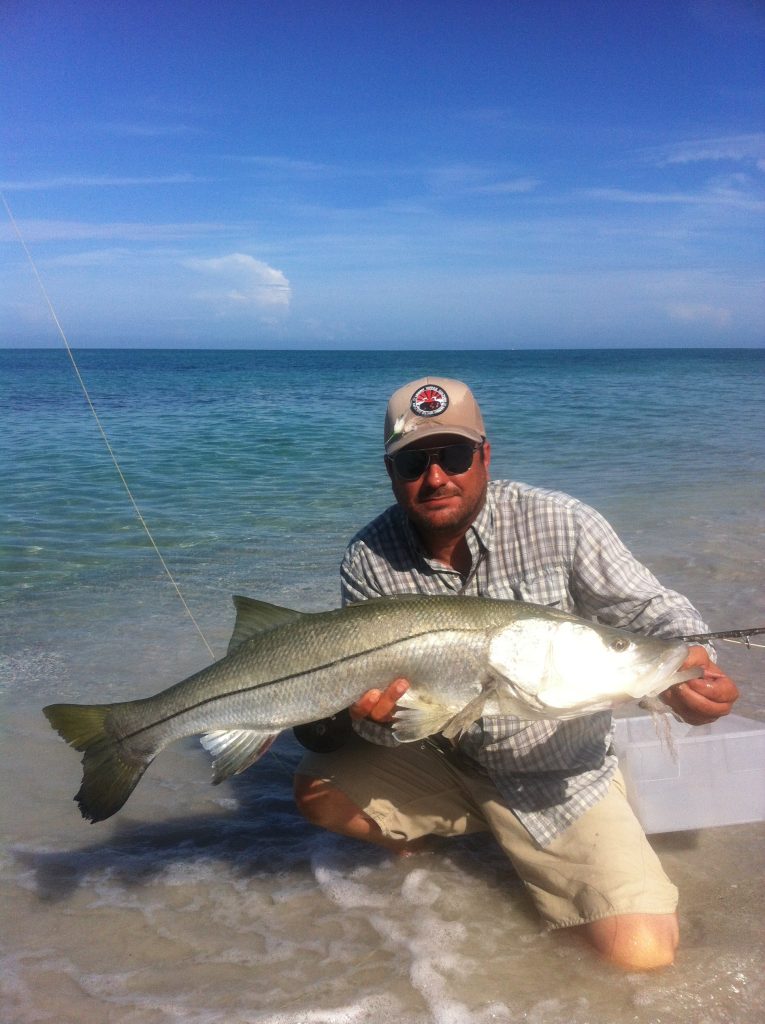Fishing for Snook, a Complete Guide
Anglers fishing for snook will find this guide very helpful. Snook are the most popular saltwater inshore game fish in Florida. Capt Jim Klopfer has been a fishing guide in Sarasota, Florida since 1991. He shares his expertise in this article. Tackle, lures and baits, techniques, seasonal migrations and more will be covered.
Snook are ambush predators that prefer to be close to structure of some sort. Snook have a large mouth that is used to inhale prey. They also have huge, powerful tails which allow for quick bursts of speed. Snook are found in the southern half of Florida as well as the very southern coast of Texas. They are a top game fish species!
Fishing for snook
Snook are a sub tropical species. They can not tolerate water that is cooler than 58 degrees for long periods of time. Therefore, they are found in the warmer parts of the country. Anglers fishing for snook will find them in Florida, from a bit north of Orlando or so south and along the very southern coast of Texas. Snook are also found in various tropical countries such as Costa Rica and Panama.
Snook are very much structure oriented. They will be found in open water on occasion. However, snook are more often located near structure. Docks, piers, mangrove shorelines, oyster bars, sea walls, and submerged rocks and ledges will all hold snook.
Seasonal snook migrations
Snook have a very distinct seasonal migration pattern. They spend the winter in backwater areas, especially creeks, rivers, and residential canals. These areas are often deeper and significantly warmer. This provides refuge from harsh winter conditions on the flats. As it warms up, the fish move out of these areas and onto the flats to feed. By summer, snook will be staging in the passes and inlets as well as being out on the beaches.
Snook spawn on the beaches and inshore open waters. They can be sight fished during summer, which is great sport! By September, most fish have moved back inside the bays, though there will still be plenty of snook in the passes and inlets. As it cools off, they move further into the backwater areas. Eventually, after a couple of severe fronts, they will once again migrate up into creeks and rivers.
Snook are found in freshwater as well!
Snook are a bit unusual in that they can tolerate water that is completely fresh as well as very salty. While several species do this when spawning, snook are one of the few fish species that migrate from salt to fresh water for seasons other than spawning. As mentioned earlier, they do this to escape cold water on the open, exposed flats.
Many a bass angler has been surprised when a large snook inhaled a lure meant for a bass! It floods in the summer in Florida quite often. Snook will move to inland lakes via the flooded rivers. They will then get trapped in lakes and ponds. Fortunately, they thrive in this environment as long as the water is deep enough to keep them warm in winter.
Best snook fishing tackle
In this section, tackle required for snook fishing will be covered. Rods, reels, lines, lures, baits, rigs, and leaders will be thoroughly discussed. Fortunately, the saltwater fishing tackle owned by most anglers will work fine.
Capt Jim wrote a very detailed article on snook fishing tackle and lures, anglers can click on the highlighted text to shop.
Spinning rods and reels for snook fishing
Snook can grow fairly large. They are also found near structure in most cases. Therefore, stout tackle is required for most anglers fishing for snook. Most opt for spinning tackle, due to it’s versatility. Spinning tackle can be used to cast an unweighted live shrimp or other light lure, while still providing enough backbone to handle a large fish.
Anglers can shop at Amazon for a Daiwa Black Gold reel and St Croix Triumph 7′ MF rod spinning combo in this link.
“Fishing Lido Key is a participant in the Amazon Associates Program, an affiliate advertising program designed to provide a means for sites to earn advertising fees by advertising and linking to Amazon. As an Amazon Associate I earn from qualifying purchases. ”
A 7′ medium-heavy rod with a “fast” action is a good all-round and versatile choice for anglers fishing for snook. “Fast” action means that the rod has a stout butt along with a limber tip. This allows for long casts with light lures while providing the necessary power. A 3000 series reel is a good match to that size rod. 20 lb braided line works well as snook are often hooked near line-cutting structure. Monofilament line can certainly be used as well. It really is just a matter of preference.
Baitcasting tackle for snook fishing
Baitcasting tackle can certainly be used by anglers targeting snook as well. It is a bit more difficult to use for novice anglers than spinning tackle. However, in skilled hands, baitcasting outfits work very well. They are especially effective when casting heavier lures such as plugs. These outfits provide a lot of power. They are also a great choice when using larger live baits near structure such as bridges. The same tackle used by largemouth bass anglers will work fine when fishing for snook.
Anglers can click these links to shop Amazon for a Shimano Calcutta reel and Teramar rod
Rigging up for snook fishing
Snook do not have teeth. However, they do have a sharp gill plate and raspy lips. This requires a “shock leader” of some sort. This is basically a short piece of stronger line that is attached between the main line and the lure or hook. There is a trade-off, though. This stronger leader is more visible to the fish. For most snook fishing, a 24″ piece of 30 lb to 40 lb flourocarbon leader is a good choice. Anglers fishing for large snook near structure may need to bump it up to 50 lb or higher leader. The leader will often become frayed after a couple of fish and will need to be re-tied.
The leader can be attached to the running line a couple of different ways. The easiest method to accomplish this is to use a swivel. This works well when using live bait. However, it can affect the action when using artificial lures. The approach most anglers use is a line-to-line knot such as a double uni-knot. It is best to double the main line with a spider hitch or Bimini Twist when using a line to line knot.
Once the leader is tied, the lure or hook is added to finish off the rig. There are many different knots that are used effectively. Every angler has his or her favorite. Most work well when tied correctly. As a fishing guide in Florida, I personally like the Uni-knot. It is easy to tie quickly and is plenty strong. The clinch knot is another proven favorite.
Fishing for snook with artificial lures
Artificial lures can be very effective when fishing for snook. Lures actually have several advantages over live bait. Snook can be very aggressive and lures can trigger strikes from these fish as well as just exciting or angering a fish into biting. Artificial lures also allow anglers to cover a lot more water than anglers fishing with live bait. Finally, fishing with lures is fun!
There are several categories of lures. These include hard plastic or wood lures, generally termed “plugs”. Jigs and soft plastic baits are very effective and versatile. Spoons are excellent lures for use on the shallow flats. Again, most of these lures are just converted largemouth bass baits.
Snook fishing with plugs
Plugs are excellent snook lures! They come in a myriad of colors, shapes, sizes, and actions. Diving plugs float on the surface and come with lips that cause them to dive to a certain depth. Lipless plugs vibrate tantalizingly when retrieved steadily. Topwater plugs float on the surface and trigger exciting strikes. Plugs are expensive and sport a pair of treble hooks, caution must be used when fishing with plugs!
Best topwater plugs for snook fishing
There are several varieties of topwater plugs. “Walk the dog” baits are baits that have no real built in action. With the rod tip low, the angler works the lure back and forth in a tantalizing manner. Zara Spook, MirroLure Top Dogs, and Rapala Skiter Walk are all examples of these types of lures. Some of these plugs have propellers on the front, rear, or both. These put up a lot of commotion. Rapala Skitter prop and the Devil’s Horse are examples.
Poppers are another type of topwater lure. They have a concave face which produces a loud noise and splash when twitched. Poppers are easier for novice anglers as they have more of a built in action. Rapala Skitter Pop and Chug Bug are examples of poppers.
All topwater plugs are worked in a similar fashion. They are cast out close to some type of cover or shoreline. The lure is allowed to settle, then twitched sharply. Poppers and prop baits are worked several times, then retrieved in and cast back out. Most bites will occur on the first few movements. Walk the dog baits can be worked back steadily back in. With all topwater plugs, it is important to wait until the weight of the fish is felt before setting the hook!
Diving plugs are very effective when fishing for snook
While topwater fishing is great fun, most snook will be caught in the water column below the surface. Diving plugs work very well for this application. These lures float on the surface and then dive down and wiggle erratically when retrieved. The size of the lip will determine the depth that the lure will work. Plugs that dive down 2′ to 6 feet work best in most instances. Rapala X-Rap and Yozuri Crystal Minnow baits are two of the many effective sub-surface plugs. These are known as “crankbaits” and “jerkbaits” by freshwater anglers.
These lures are fairly easy to use. The plug is cast out to a likely spot, then retrieved back in using sharp twitches followed by a pause. Often times, the strike occurs as the bait sits there motionless, seemingly helpless. The plug used should match the local forage in both size and color. However, an erratic lure that is larger may draw a strike from a snook.
Lipless plugs for snook
Lipless plugs are effective and very easy to use. They sink when cast out and are simply retrieved back in using a steady pace. The angler can feel the vibration through the rod. They are also effective for trolling in rivers and canals. The venerable Bill Norman Rat-L-Trap is the top lipless bait. Chrome with a blue back is a great all around color.
Some lipless plugs sink slowly and suspend when twitched. They do not vibrate when reeled in. These can be very effective on snook when they are a bit finicky. The best example of this type of plug is the MirroLure MirroDine.
Snook fishing with jigs and soft plastic baits
Soft plastic lures are deadly on snook, as well as just about every fish that swims in both fresh and salt water! They come in a myriad of shapes, sizes, colors, and actions. They can imitate crustaceans such as shrimp and crabs along with bait fish. Some resemble neither but still catch fish. Soft plastic lures can be fished on a hook, a weighted hook, and on a jig head.
The jig and grub combination is perhaps the most often used soft plastic bait for snook fishing. Jigs come in a variety of weights and hook sizes. This allows anglers to adapt their baits to the depth needed. Heavier jig heads can be used in deeper water or when tides are swift. Conversely, lighter jig heads work well in shallow water. Both bait fish and shrimp tails work well when fished on a jig head.
Special rigging hooks for soft plastic baits
Soft plastic baits can also be used on special hooks. Once again, these were developed by bass anglers. They have a wide gap and can be rigged weedless. Some are weighted as well. The weight is on the bend, resulting in a lifelike horizontal presentation. This rig works great in shallow grass.
There are countless manufacturers who design and sell quality baits. Popular lures vary by region. There really are too many to list. When presented correctly, all will catch fish. There are scented soft plastic baits as well. By far the most effective is the Gulp line of baits. They cost a bit more, but they can make a difference on a tough day.
Catching snook on jigs
Anglers can fish for snook with jigs that have a permanent dressing. Bucktail jigs have been around a very long time and still catch fish. While is a very popular color as it mimics a bait fish. Hair jigs are less versatile as the color can not be easily changed. They are also a bit more expensive. However, some anglers swear by them.
Using spoons when fishing for snook
Spoons are a very effective snook lure as well. They are heavy, curved pieces of metal. They can be cast a long way and wobble in an enticing manner. Weedless spoons such as the Johnson Silver Minnow, another great bass lure, work very well when searching for snook on shallow flats. They can be worked in water as shallow as a foot deep. These spoons have a single hook which rides up in the water, as well as a weed guard.
Spoons can be used on the beaches, in passes and inlets, and over deeper flats as well. Silver is the most popular finish and is used in clear water. Silver spoons work great when snook are feeding on the surface. Small spoons can be effective fishing the lighted docks and bridges at night. Most have an open treble hook.
Snook fishing with live bait
Live bait catches a lot of snook. Shrimp are available all year long at most Florida bait shops. A large, live shrimp is a terrific snook bait, especially in winter. Live bait fish such as pinfish, grunts, croakers, mullet, threadfin herring, and scaled sardines are all effective live baits for snook.
Live bait fishing hooks and rigs
There are many different styles and sizes of hooks. Hook size should be matched to the size of the bait, not the size of the snook being targeted. 1/0 is a good all around hook size. Short shank live bait hooks such as the Eagle Claw work well. Many anglers prefer using circle hooks which usually result in the fish being hooked in the corner of the mouth. When using circle hooks, anglers must not set the hook. Instead, they just reel up the slack and gently raise the rod tip.
Free lining a bait works very well in light current and fairly shallow water. It results in a very natural presentation with both shrimp and bait fish. A split shot can be used to add casting weight and to get the bait down in the water column if needed. This works great around shallow docks and along mangrove shorelines.
Weights and floats for snook fishing with live bait
While free lining a live bait can be very effective, there are situations that require either weight or floats to present a live bait naturally. Anglers fishing in deeper water or where current is present will often times need to add weight to get the bait down in the water column. Conversely, anglers will at times need to suspend a live bait up off the bottom. This is done using a float or bobber.
Using weights when snook fishing with live bait
There are several methods that anglers use to get a live bait down deeper when fishing for snook. This can be as simple as a couple of pinch on split shot. this method works well when fishing structure that is fairly shallow or when current is light.
Anglers snook fishing in deeper water or and heavier current will need to add more weight. The most common approach is to use a sliding egg sinker on the main line above a swivel. A 2 foot to 3 foot section of fluorocarbon leader is then added between the swivel and a hook. the rule of thumb when bottom fishing is to use the least amount of weight required to hold the bottom. Successful anglers constantly adjust the weight to the ever-changing strength of the current flow.
Using floats when snook fishing with live bait
Floats, also known as “corks” or “bobbers” can be a very effective tool to use when fishing live bait for snook and other species. Floats are most often used in shallow water. They have several functions. Floats add casting weight, suspend the bait at the desired depth above the bottom, and provide a visual reference for a strike.
Floats come in several different styles. However, they all basically work the same. The general idea is to suspend the bait just above the bottom, which is often times grass. Left to its own devices, some bait fish will quickly dive down into the grass. The float prevents this from happening. Floats also let an angler know exactly where the bait is in relation to the cover being fished. Finally, the float quickly disappearing from sight is a clear indication that a strike has occurred!
Live bait chumming
Live bait chumming is an incredibly effective technique that is used in the warmer months when snook fishing in Florida. Using cast nets, anglers load the bait well with hundreds of live baits. Small silvery fish such as threadfin herring and scaled sardines are most commonly used as they can be caught in large numbers quickly and easily. Once the bait is acquired, the fishing can start.
The boat is anchored up wind and up tide of a likely snook holding spot. Then, a dozen or so live baits are tossed out behind the boat. This is repeated a few minutes later. Anglers will sometimes squeeze the bait fish, crippling them. This results in the bait fish swimming very erratically on the surface. In most instances, if snook are present they will start eating the chum. Once this happens, hooked live baits are tossed out and a hook up generally ensues.
Snook fishing techniques
One great thing about snook fishing is that there are many different ways to catch them. Snook can be caught along the mangrove shorelines on the shallow flats for much of the year. They are found in the passes and inlets as well is out on the beaches in the warmer months. Anglers fishing for snook in creeks and rivers do well in the cooler months. Fishing lighted docks and bridges can be effective all year long.
Snook fishing on the flats and inshore waters
Fishing for snook in the bays and backwater areas is quite similar to freshwater fishing for bass. Many opt for artificial lures as they allow the angler to cover a lot of water in a relatively short amount of time. Live bait can certainly be effective, especially when a group of snook is found holding in a certain location.
Plugs, spoons, and soft plastic baits are all effective lures for snook fishing in the bays. Topwater plugs are an excellent choice early and late in the day or when cloud cover is present. Shallow diving plugs work best when the sun is up. Soft plastic baits fished on a jig head or rigging hook will produce snook at any time. Weedless spoons are a great choice when searching for snook on large expansive grass flats.
Snook are ambush predators and will set up feeding stations in certain areas. Any point or piece of structure such as a dock, rocky outcropping, bridge, or oyster bar with a little bit of depth and current flow is a likely spot to catch a fish. Current flow is crucial as it will position the fish on a piece of structure. Fish will often times position themselves in the spot where the structure breaks the current flow. This is a perfect ambush position.
Snook fishing in passes and inlets
Anglers seeking a trophy snook will do well to target them in the passes and inlets in the warmer months. Snook will school up in very large numbers at this time of year in preparation to spawn. Several of the Florida East Coast inlets are famous for their fantastic summer snook fishing! passes along the south west coast of Florida are very productive as well.
While artificial lures can be used around structure such as jetties, docks, and rip-rap, live bait is often the best choice when snook fishing and inlets and passes. This is especially true on the East Coast of Florida where the water is deep and the currents are swift. Anglers use heavy tackle and quite a bit of weight to present a live pin fish, grunt, croaker, or mullet on the bottom. This is a very effective technique which produces some of the largest fish of the year.
The best time to fish the inlets and passes for snook is on the outgoing tide. As the water flushes out of the bays it brings the bait fish and crustaceans to the waiting game fish. If these tides occur early or late in the day, so much the better. Anglers also do well fishing the passes and inlets at night, though care is required. Free lined live shrimp work very well at night around structure on an outgoing tide.
Snook fishing on the beaches
There is some great sport to be had by anglers fishing for snook off of the Florida beaches. The best part is, no boat is required! When conditions are right, snook can actually be site fished by anglers as a are seen cruising the surf line. This is a great opportunity for anglers who like to fly fish as well as light tackle spin fishing. in most cases, there are few obstructions for the snook to break an angler off on. This allows them to use fairly light tackle.
This truly is world-class sight fishing. There are really not that many opportunities in the world were anglers can cast to a fish that weighs 20 pounds are more with fairly light tackle while not requiring a boat. Most anglers simply walk the beach while scanning the surf for fish. Once spotted, the lure or fly is cast out in front of them. Due to the fact that anglers are walking, most choose to use artificial lures for this type of fishing. Small white buck tail jigs, soft plastic baits, small plugs, and small Silver spoons are all effective baits.
Live bait can be effective when snook fishing off the beach as well. This is particularly true when fishing some type of structure or when the surf is rough and visibility is poor. Any live bait fish, particularly one that can be caught in the surf itself, can be productive. Live shrimp will produce fish as well. Anglers can simply cast the bait out in the first trough or towards some type of structure such as a dock or submerged rocks.
Fly fishing for beach snook
Fly anglers can enjoy some fantastic fishing off the beach when targeting snook in the summer time! The opportunity to catch a large snook on a fly rod while sight casting is definitely an attraction. An 8 wt or 9 wt outfit with an intermediate sink tip line works best. A 9 foot tapered leader with a 30 lb bite tippet is a good all-around choice, especially if the water is clear. Any proven snook fly can be productive, with white being the favorite color. White D.T Specials, Crystal Minnows, and Clouser Minnows tied on a #1 or #1/0 hook are all good choices.
Snook fishing and rivers, creeks, and canals
Snook migrate up into creeks, canals, and rivers when the water gets cold. In a snook’s world, anything below 58° is cold. Water in residential canals, creeks, and rivers is almost always warmer, sometimes up to 10°. River and creek waters are often tannin stained and dark, which absorbs the warmth from the sun. Many rivers also have holes that are quite deep which offer refuge to snook as the water gets cold. Residential canals are often usually fairly deep with a lot of concrete seawalls that absorb winter warmth.
The two primary snook fishing techniques in these areas are trolling and casting artificial lures. While live bait can produce, in most cases it is best to cover as much water as possible. Shallow diving plugs such as the Rapala X-Rap work very well in this application. these lures can be both cast and trolled effectively. Casting plugs and lures works best in rivers and creeks as there are often spots that are too shallow to troll. Trolling is very effective in the deeper residential canals which are lined with docks.
River snook fishing charters offer anglers a unique experience. These areas are full of natural scenery and wildlife. It is a very cool environment to target fish in. This is generally not a numbers game but more a “quality over quantity” situation. Anglers can read a more detailed article on river snook fishing by clicking on the link.
Night snook fishing
While many snook are caught during the day, snook are nocturnal feeders, they do most of their eating in the dark. Most anglers targeting snook at night fish lighted docks and bridges. The lights attract plankton along with bait fish and shrimp. The forage, along with the structure, result in a fantastic fish holding environment. Bridges are most often built on narrow sections of waterways. This results and even stronger current flows in most instances. Outgoing tides are preferred. Areas in and near passes and inlets are often the top spots to fish.
Anglers fishing for snook at night do well using both artificial lures and fly as well as live live bait. Small lures and flies that imitate bait fish and shrimp will do well. This includes plastic shrimp, soft plastic lures, and plugs. In most cases, shrimp are the best live bait. However, anglers seeking a trophy snook will use heavy tackle and fish a larger live bait such as a mullet or pin fish down deep near the structure. This can pay off in the fish of a lifetime!
The best approach when night snook fishing is to anchor the boat a cast away from the lighted dock or bridge fender either perpendicular to or a bit up current of the structure. The lure or bait is then cast into the dark area above the shadow line created by the light. This results in a very natural presentation as the tide sweeps the bait down into the light. Warning; night snook can be notoriously fussy! There will be nights where fish are seen stacked up and the light but are difficult to get to bite.
Snook fishing seasons
Snook have a predictable migration pattern. This holds true throughout the entire state of Florida and in the small portion of Texas. There will be a slight variance as temperatures do lag a bit and South Florida versus the middle part of the state. However, this calendar of snook fishing seasons will hold true for the most part.
Fishing for snook in winter
Snook will be found in creeks, rivers, and residential canals in the winter unless it has been unseasonably warm. The best natural creeks and rivers are winding with many turns and holes with deeper water. The spots will concentrate fish. The back ends of creeks and residential canals will often times hold schools of snook. casting shallow diving plugs and soft plastic jerk baits towards likely fish holding structure is the best technique.
Many residential canals are long and straight without many turns and lined with docks. Therefore, trolling is often the best approach. Anglers will use fairly heavy tackle and trolling large or plugs along the edges of the docks. This allows them to cover a lot of water in search of a big snook. Large Jack crevalle will often times be caught using this technique is well, which is a nice added bonus.
Fishing for snook in spring
Spring is a great time to go snook fishing! Fish will be moving out of their winter hunts and will be in the mood to feed. Flats and backwater areas that are close to larger creeks, rivers, and canals will be the best spots in early spring. As it warms up, snook will scatter out while moving towards the passes and inlets. Anglers targeting mangrove shorelines on the higher tide stages will do well. Docs, points, and other structure that breakup a shoreline are prime feeding spots on an outgoing tide. Bridges and docs will produce at night.
Anglers fishing for snook in the spring can choose from a variety of techniques. Shallow diving plugs and soft plastic baits are great choices when probing a long shoreline. Colors and sizes should match the forage that is in the area. 1/2 ounce gold weedless spoons work very well when covering large shallow grass flats with potholes. Live shrimp and bait fish are good choices for fishing docks and other structures that hold snook.
Fishing for snook in summer
Summer is a great time for an angler to catch a trophy snook. They will stack up in large schools and inlets and passes as well is moving out onto the local area beaches. Passes and inlets with abundant structure are the best spots to try. Beaches close to inlets and passes as well as those with some type of structure such as rocks, docks, or other structures will generally hold the most fish.
Anglers fishing for snook in summer will do well fishing with live bait near structure in the deeper parts of the passes and inlets. Pin fish, grunts, croakers, sardines, herring, and mullet will all produce as will a live shrimp and crabs. Fairly heavy tackle will be required to land a large fish in heavy current. Lures cast a long jetties will fool snook early and late in the day. Anglers can also choose to sight fish for snook along the beaches.
Fishing for snook in fall
Fall is a glorious time to be fishing in Florida! The weather is normally beautiful and the crowds are gone. Snook will be moving out of the passes and inlets and into the backwater areas. The same spots and techniques that produced in the spring will produce again in the fall. Chumming with live bait fish is very popular and productive as the bait is usually easy to catch this time of year. Shorter days and cooling water temperatures have the fish in a mood to feed. In conclusion, this article on fishing for snook will help anglers catch more of these terrific game fish!
